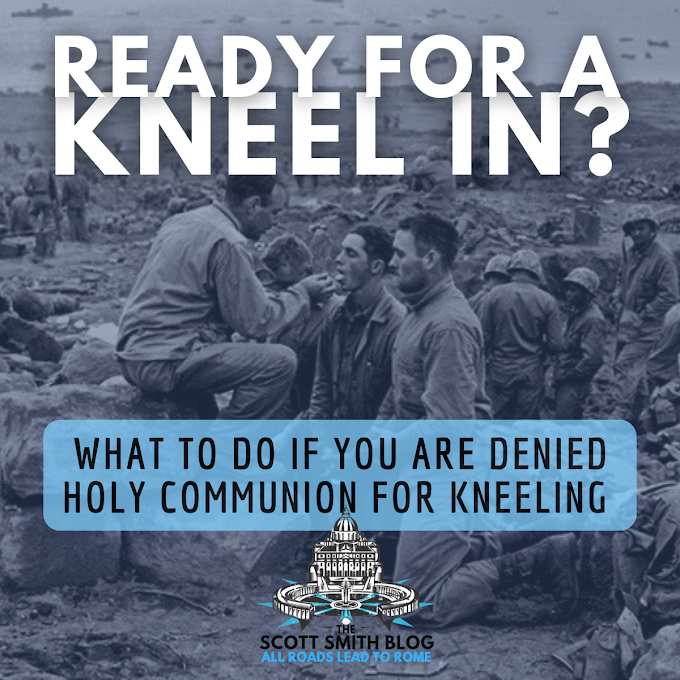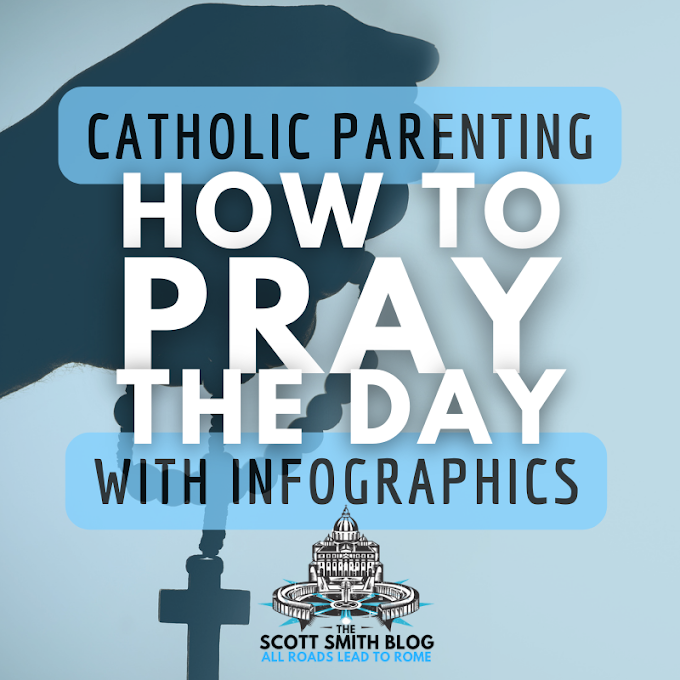Why does Jesus curse that poor fig tree at Mark 11? What did that fig tree ever do to Him? It's a mysterious event in the Gospels, right? It's also a significant event in the Gospels.
Unfortunately, most scholars sort of scratch their head at this passage. At best, they'll say the fig tree represents the Jewish people, who have also failed to bear fruit. But there's so much more to this story!
Why is this cursed fig tree so significant? Because this event happens during Holy Week. Holy Monday, to be specific.
Is Jesus just having a case of the Mondays? Cursing trees, kicking stumps, etc.? It is, after all, the start of the most brutal week of His life.
There is no insignificant detail in the days leading up to Christ's Passion, Death, and Resurrection. All salvation history has been leading up to these moments. So no, this incident with the fig tree is no minor detail.
This sad fig tree helps tie together the entire sweep of salvation history!
For a great resource on all this, check out Dr. Brant Pitre's The Jewish Roots of Holy Week. Here is a clip from Dr. Pitre's talk: (the section on the cursing of the fig tree isn't freely available on YouTube, though)
What actually happened between Jesus and this fruitless, hapless fig tree?
Let's turn to the Gospel of Mark.
The Cursing of the Fig Tree: Mark 11:12-14, 20-25
Here is the account of Jesus cursing the fig tree at Mark 11:
[12] On the following day, when they came from Bethany, he was hungry. [13] And seeing in the distance a fig tree in leaf, he went to see if he could find anything on it. When he came to it, he found nothing but leaves, for it was not the season for figs. [14] And he said to it, “May no one ever eat fruit from you again.” And his disciples heard it.
Jesus was "hungry," went to the fig tree, and found nothing but leaves.
So Jesus curses the fig tree, because He was hungry and angry -- "hangry" -- and found no food ... right?
Wrong. Well, mostly wrong.
Look at the words of Jesus so-called curse: "May no one ever eat fruit from you again." What does this mean? Is this truly a curse? Or, is it the breaking of a curse? We have to ask what was this eating of fruit that Jesus is condemning and ending. Forever.
Also, this isn't all that's said about this fig tree. St. Peter tells us about the pitiful aftermath that befell this fruitless fig.
This occurs just a few verses later at Mark 11:20-25:
[20] As they passed by in the morning, they saw the fig tree withered away to its roots. [21] And Peter remembered and said to him, “Master, look! The fig tree which you cursed has withered.” [22] And Jesus answered them, “Have faith in God. [23] Truly, I say to you, whoever says to this mountain, ‘Be taken up and cast into the sea,’ and does not doubt in his heart, but believes that what he says will come to pass, it will be done for him. [24] Therefore I tell you, whatever you ask in prayer, believe that you receive it, and you will. [25] And whenever you stand praying, forgive, if you have anything against any one; so that your Father also who is in heaven may forgive you your trespasses.”
So, what just happened?? What is this curse all about?
What is the connection between the fig tree and Holy Week? Between this cursed tree and Jesus' work of salvation?
And wasn't Nathanael also sitting at fig tree in John 1? Why do figs keep appearing in the Gospels?
Where Else Do We See Fig Trees in the Bible?
Proverbs 27:18 tell us that "He who tends a fig tree will eat its fruit, and he who guards his master will be honored."
Is this the answer? Nope! Jesus definitely did not find figs on Holy Monday, and woe to the fig tree.
So where else do we find figs described in the Bible?
There is on pre-eminent fig tree in the Bible. One Biblical fig tree absolutely towers above all the rest. Do you know which Tree it is?
What Was The Tree of Knowledge of Good and Evil?
The Tree of Knowledge of Good & Evil was an apple tree, right? That's how it's depicted in all the paintings. Plus, there's the Apple logo:
Surely this is a depiction of Adam and Eve's half-eaten apple, right?
Here is Genesis 3:6-7. It the description of the Fall of Man and Original Sin:
So when the woman saw that the tree was good for food, and that it was a delight to the eyes, and that the tree was to be desired to make one wise, she took of its fruit and ate; and she also gave some to her husband, and he ate. Then the eyes of both were opened, and they knew that they were naked; and they sewed fig leaves together and made themselves aprons. (Genesis 3:6-7)
Wait a tick! What kind of leaves did they sew together? You got it. Fig.
Remember that Jesus "found nothing but leaves" when he inspected the fig tree. And when God inspected the Garden of Eden after the Fall? God likewise found Adam & Eve clothed in nothing but leaves.
Fig Leaf Underwear? Ouch.
By the way, fig leaves were not an ideal choice for undergarments. Have you ever picked figs? This Louisiana boy has. Fig leaves are scratchy. Fig sap is itchy. Adam & Eve's fig-based Fruit of the Loom underwear were basically the first hair shirts.
Therefore, Original Sin was followed by Original Confession was followed by Original Penance!
Here's a little comic I drew to illustrate this many years ago.
What Kind of Leaves Did Adam & Eve Make Clothes From? What Kind of Fruit was the Forbidden Fruit of the Tree of Knowledge of Good & Evil?
So, what kind of leaves did Adam & Eve sew together to make clothes? Fig.
So what? Adam & Eve sewed fig leaves together to make their clothes, AND Figs are the only fruit mentioned in Genesis' account of the Fall BUT that doesn't mean the Tree of Knowledge of Good & Evil was a fig tree. Right? Wrong.
The Tree of Knowledge of Good & Evil has long been held to be a fig. Not an apple. Read more about this HERE: Did You Know ... The Fruit of the Tree of Knowledge was NOT an Apple?
But there's more. More documentary evidence exists to show that the fig was the fruit of the Tree of Knowledge of Good and Evil.
There’s an ancient Jewish book. It's not part of the Bible. It’s called The Life of Adam and Eve. It's not nearly as ancient as Genesis -- it’s only from the First Century AD, from the time of Jesus. It is a collection of ancient Jewish traditions and beliefs.
In The Life of Adam and Eve, Eve says the following:
At the very moment my eyes were open, I knew that I was naked of the righteousness with which I had been clothed. I looked for leaves, so that I might cover my shame, but I did not find any from the trees of paradise, except those of the fig tree only. And I took its leaves, and I made for myself skirts. They were from the same plants of which I ate. (Life of Adam and Eve 20:1, 4-5)
There it is. This answers the ancient question: what kind of fruit was the Forbidden Fruit, the fruit of the Tree of Knowledge of Good and Evil? Fig.
So, Why Does Jesus Curse the Fig Tree, The Tree of Knowledge of Good & Evil?
You can probably see where this is headed, right? By this point, the answer might be speaking for itself.
Jesus is not cursing that one, poor, hapless fig tree. Jesus is cursing the death which came from disobeying God, from eating of the Tree of Knowledge of Good and Evil. The Tree of Death.
Jesus is cursing death, itself.
Why? This is Holy Week. Jesus is about to put death, itself, to death.
Remember Jesus' words. The words of Jesus' so-called curse: “May no one ever eat fruit from you again.”
Jesus is saying, "May no one ever eat of death again."
The reign of sin and death is quickly coming to death as Jesus approaches the fig tree. The withered fig tree is one of the first stops along Calvary and the Via Dolorosa.
Jesus is not cursing the fig tree. Jesus is announcing His coming victory over death!
So, thankfully, the fig is not cursed. The beautiful, tasty fig of my youth and life is not subject to Jesus' curse.
Want More of This? Want a Richer Reading of the Bible?
I hope you enjoyed this article. I hope you're saying why wasn't I ever taught this about the fig tree? The Bible is full of rich, but overlooked images just like this.
I published a whole book and and e-course like this on the Virgin Mary: What You Need to Know About Mary But Were Never Taught. Click below to enroll:


















3 Comments